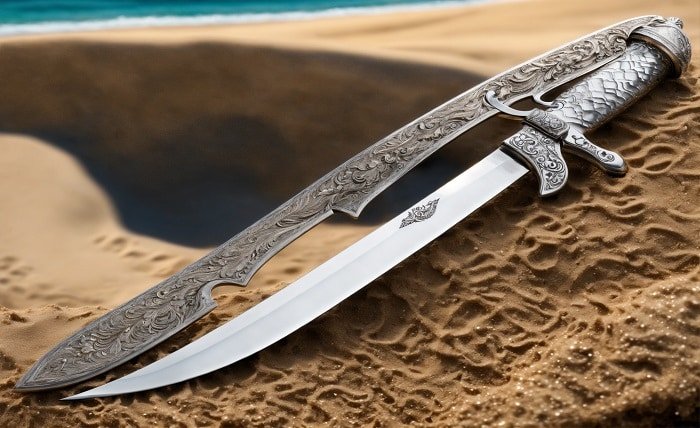Mini Katana: A Mighty Weapon in a Small Package

Introduction
In the realm of Japanese weaponry, the mini katana stands out as a testament to the adage “big things come in small packages.” This diminutive yet deadly blade has captivated enthusiasts and collectors alike with its exquisite craftsmanship and formidable capabilities. In this article, we delve into the fascinating world of the mini katana, exploring its history, construction, and modern-day relevance.
Origins and Evolution
The roots of the mini katana trace back to ancient Japan, where its larger counterpart, the traditional katana, reigned supreme on the battlefield. Over time, craftsmen sought to replicate the katana’s design on a smaller scale, giving rise to the mini katana. These miniature marvels were not only prized for their aesthetic appeal but also revered for their practicality in close-quarter combat.
Craftsmanship and Design
Crafting a mini katana requires the same level of precision and skill as its larger counterpart. Expert swordsmiths meticulously forge the blade from high-quality steel, honing its edge to razor sharpness. The hilt, or tsuka, is intricately wrapped with traditional materials such as silk or leather, ensuring a firm grip for the wielder. Despite its diminutive size, every aspect of the mini katana’s design is carefully considered to optimize its balance and functionality.
Applications and Utility
Despite its modest dimensions, the mini katana is a versatile weapon with a wide range of applications. From martial arts training to self-defense, this compact blade excels in various scenarios where agility and precision are paramount. Additionally, collectors and enthusiasts appreciate the mini katana for its aesthetic appeal and historical significance, often displaying it as a prized artifact in their collections.
Modern-Day Relevance
In the contemporary era, the mini katana continues to hold sway as a symbol of Japanese martial prowess and craftsmanship. While no longer wielded on the battlefield, it remains a popular choice for practitioners of martial arts such as Kendo and Iaido, where its compact size offers distinct advantages in training and sparring. Moreover, its cultural significance ensures a steady demand among collectors and aficionados worldwide.
The Art of Display
Beyond its utilitarian functions, the mini katana is also prized for its aesthetic appeal. Many collectors invest in elaborate display stands and cases to showcase their prized blades, transforming them into works of art worthy of admiration. Whether mounted on a wall or displayed in a glass cabinet, the mini katana commands attention and reverence as a symbol of Japanese heritage and craftsmanship.
Collecting and Preservation
For avid collectors, acquiring and preserving mini katanas is both a passion and a responsibility. Proper storage and maintenance are essential to prevent rust and corrosion, ensuring that these exquisite blades retain their luster and sharpness for generations to come. Additionally, enthusiasts often seek out rare and unique specimens, adding to the richness and diversity of their collections.
The Legacy Continues
As we look to the future, the legacy of the mini katana endures as a timeless testament to Japanese martial arts and craftsmanship. Its allure transcends generations, captivating admirers with its beauty and functionality. Whether wielded in training or admired as a piece of art, the mini katana remains a cherished symbol of Japan’s rich cultural heritage.
Conclusion
In conclusion, the mini katana stands as a testament to the ingenuity and craftsmanship of Japanese swordsmiths. Despite its diminutive size, this compact blade embodies the spirit of the traditional katana, offering a potent combination of elegance and lethality. Whether wielded in combat or admired as a collector’s item, the mini katana continues to captivate enthusiasts worldwide with its timeless appeal.
FAQs
1. Are mini katanas functional weapons, or are they purely decorative?
Mini katanas can serve both practical and decorative purposes. While some are crafted solely for display, others are designed with functional blades suitable for martial arts training or even self-defense.
2. How do I care for and maintain a mini katana?
Proper maintenance involves regular cleaning and oiling to prevent rust and corrosion. Additionally, storing the blade in a dry environment away from moisture and humidity helps preserve its quality over time.
3. Can I customize a mini katana to suit my preferences?
Yes, many craftsmen offer customization options for mini katanas, allowing buyers to choose different blade lengths, materials, and designs according to their preferences.
4. Are mini katanas legal to own and carry in various countries?
Laws regarding the ownership and carrying of mini katanas vary depending on the country and local regulations. It’s essential to familiarize yourself with the relevant laws in your area to ensure compliance.
5. Are there any famous mini katana wielders in history?
While traditional katanas have been wielded by famous samurai throughout history, there are fewer documented instances of mini katana use. However, these compact blades have undoubtedly played a role in Japanese martial arts training and culture for centuries.




